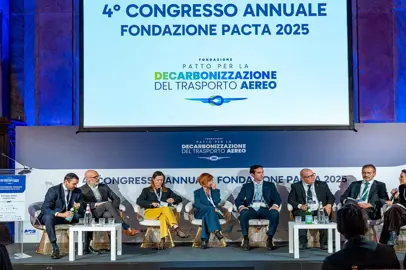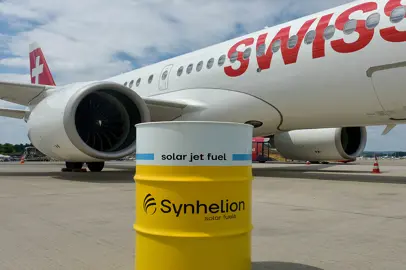27 November 2023
Carbon cutting fuel use grows at Heathrow
Heathrow’s pioneering Sustainable Aviation Fuel scheme will incentivise the use of up to 155,000 tonnes of SAF at the airport in 2024, which targets the equivalent of 341,755 tonnes of carbon cut from flights
Airlines at London Heathrow Airport are anticipated to use record amounts of Sustainable Aviation Fuel (SAF) next year as the airport extends its carbon cutting scheme for a third year. In 2024, £71m will be available to airlines through the incentive, targeting up to 2.5% of aviation fuel used at Heathrow to be SAF and if achieved, amounting to 155,000 tonnes of aviation fuel.
The scheme encourages airlines to switch to SAF by approximately halving** the price gap between kerosene and its greener alternative, making SAF a commercial reality for airlines. In 2024, the scheme is targeting up to 341,755 tonne reduction of carbon equivalent emissions from flights if 70% GHG emissions reduction is achieved. This is equivalent to over 568,000 passenger round trips from London (Heathrow) to New York.***
Heathrow is aiming for 11% SAF usage by 2030, scaling up the incentive year on year. Integrating SAF into the fuel supply is one of the airport’s most significant steps to cut carbon, on the road to net zero by 2050.
SAF is an alternative to traditional fossil-fuel based kerosene which can deliver up to 70% carbon savings in the lifecycle by using feedstocks like used cooking oil and other kinds of waste. The technology is proven, with hundreds of thousands of flights already powered in part by SAF. It can be dropped into existing aircraft at up to a 50% blend (in future 100% blend) with no need for infrastructure or aircraft engine changes. It will be showcased on the world stage during the upcoming (28 November) Virgin Atlantic 100% SAF flight from Heathrow to New York JFK.
This announcement comes as the Chancellor missed a prime opportunity to invest in a UK SAF industry during the Autumn Statement. Thousands of jobs, billions added to the economy and the UK’s fuel security are within grasp if Government creates a policy environment which cultivates UK SAF production. Low production volumes and high costs remain the barrier to wider SAF use – which is where Heathrow’s incentive scheme is helping to bridge the gap.
While recent Government commitments to consult on a SAF revenue certainty mechanism are welcome, more urgency is required from policymakers in bringing forwards legislation that supports the UK in the global SAF race. As the UK stalls, the US and EU are marching ahead, driving billions of investment into greener fuel through Government incentives and mandates.
Ministers needs to act now to secure Britain’s world-leading aviation sector’s future, in a world without carbon.
Heathrow Director of Carbon, Matt Gorman said: “Sustainable Aviation Fuels are a proven reality – they have already powered hundreds of thousands of flights and we will soon show we can fly the Atlantic fossil fuel free. Heathrow’s first of its kind incentive scheme has seen SAF use at the airport ramp up in recent years. Now, the Government needs to capitalise on this strong demand and legislate for a revenue certainty mechanism to enable a home-grown SAF industry, before it is too late for the UK to benefit from jobs, growth and energy security this would bring.”
Note:
* The ICAO Chicago Convention Annex 16 Vol IV defines the global average baseline for conventional aviation life cycle emissions. The 70% lifecycle emissions savings were calculated using this baseline.
** The SAF Incentive is calculated by reference to reducing the premium price gap between fossil kerosene and SAF fuel by approximately 50%. For the purpose of the SAF Incentive in 2024, Heathrow has assumed the premium to be £920 GBP per tonne net of Renewable Transport Fuels Certificate (RTFC) value, so will incentivise SAF delivery to Heathrow Airport on the basis of £460 per tonne.
*** Calculated using the ICAO carbon calculator which states one passenger round trip LHR-JFK equates to 598kg.
** The SAF Incentive is calculated by reference to reducing the premium price gap between fossil kerosene and SAF fuel by approximately 50%. For the purpose of the SAF Incentive in 2024, Heathrow has assumed the premium to be £920 GBP per tonne net of Renewable Transport Fuels Certificate (RTFC) value, so will incentivise SAF delivery to Heathrow Airport on the basis of £460 per tonne.
*** Calculated using the ICAO carbon calculator which states one passenger round trip LHR-JFK equates to 598kg.
Heathrow
Heathrow is the UK’s international gateway, the largest airport in Europe and the most connected megahub in the world – connecting to 239 destinations in 89 countries. The airport welcomes over 200,000 passengers on roughly 1,300 flights each day, and serves as a Britain’s hub for trade, tourism and investment. Approximately 75,000 people work at Heathrow – the airport directly employs about 10% of them, with the rest working for Team Heathrow partners including airlines, ground handlers and retailers.
Edited by editorial staff, Avion Tourism Magazine
Text source: Copyright © Heathrow Press
Photo: Copyright © Sisterscom.com / Depositphotos
You might be interested in
Sustainability

Sustainable Mobility
Emirates' sustainable amenity kits
New designs for pouches made from bio materials, illustrations of endangered species, and Aveda products in the new Premium Economy and Economy amenity kits for long-haul flights
Sustainability

Sustainable Mobility
The 4th Annual Congress of the PACTA Foundation in Rome
A discussion on the challenges and opportunities of the energy transition of air transport, to accompany the sector towards the achievement of Net Zero goals
Sustainability

Sustainable Mobility
Swiss accelerates the use of sustainable fuels
Strategic partnership for the development of Synhelion's synthetic Sustainable Aviation Fuels


